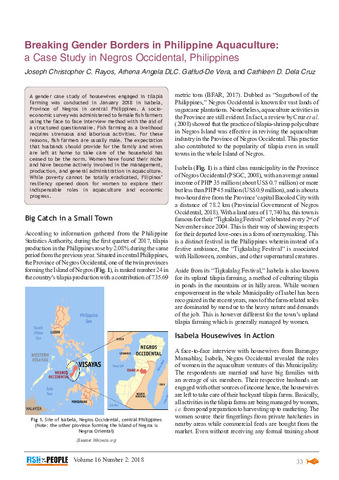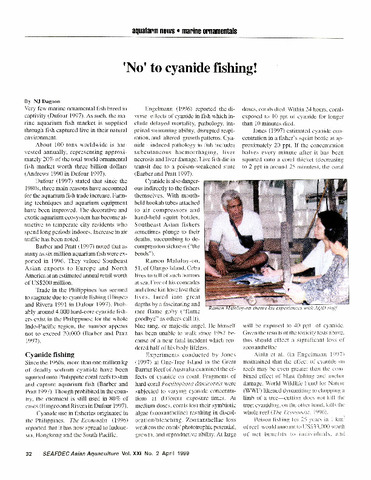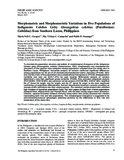Breaking gender borders in Philippine aquaculture: A case study in Negros Occidental, Philippines
Share
ບົດຄັດຫຍໍ້
A gender case study of housewives engaged in tilapia farming was conducted in January 2018 in Isabela, Province of Negros in central Philippines. A socioeconomic survey was administered to female fish farmers using the face to face interview method with the aid of a structured questionnaire. Fish farming as a livelihood requires strenuous and laborious activities. For thesereasons, fish farmers are usually male. The expectation that husbands should provide for the family and wives are left at home to take care of the household has ceased to be the norm. Women have found their niche and have become actively involved in the management, production, and general administration in aquaculture. While poverty cannot be totally eradicated, Filipinos’resiliency opened doors for women to explore their indispensable roles in aquaculture and economicprogress.
Suggested Citation
Rayos, J. C. C., Gaffud-De Vera, A. A. D., & Dela Cruz, C. D. (2018). Breaking gender borders in Philippine aquaculture: A case study in Negros Occidental, Philippines. Fish for the People , 16(2), 33-35. http://hdl.handle.net/20.500.12066/1375
ວິຊາ
Collections
Related items
Showing items related by title, author, creator and subject.
-
Research on marine and freshwater fishes
Emata, Arnil C. (Aquaculture Department, Southeast Asian Fisheries Development Center, 1995)Most of the fish research at SEAFDEC AQD in 1992-1994 was on milkfish. Studies were conducted on year-round spawning through hormonal or environmental manipulation; optimum lipid and protein levels and ration size for ... -
'No' to cyanide fishing!
Dagoon, N. J. (Aquaculture Department, Southeast Asian Fisheries Development Center, 1999) -
Morphometric and morphomeristic variations in five populations of indigenous Celebes goby Glossogobius celebius (Perciformes: Gobiidae) from Southern Luzon, Philippines
Corpuz, Mark Nell C.; Camacho, Ma. Vivian C.; Ocampo, Pablo P. (College of Agriculture, University of the Philippines Los Baños, 2013)To elucidate the population structure and pattern of morphological divergence of the indigenous Celebes goby Glossogobius celebius (Valenciennes, 1837), morphometric and morphomeristic characters of this species were ...





